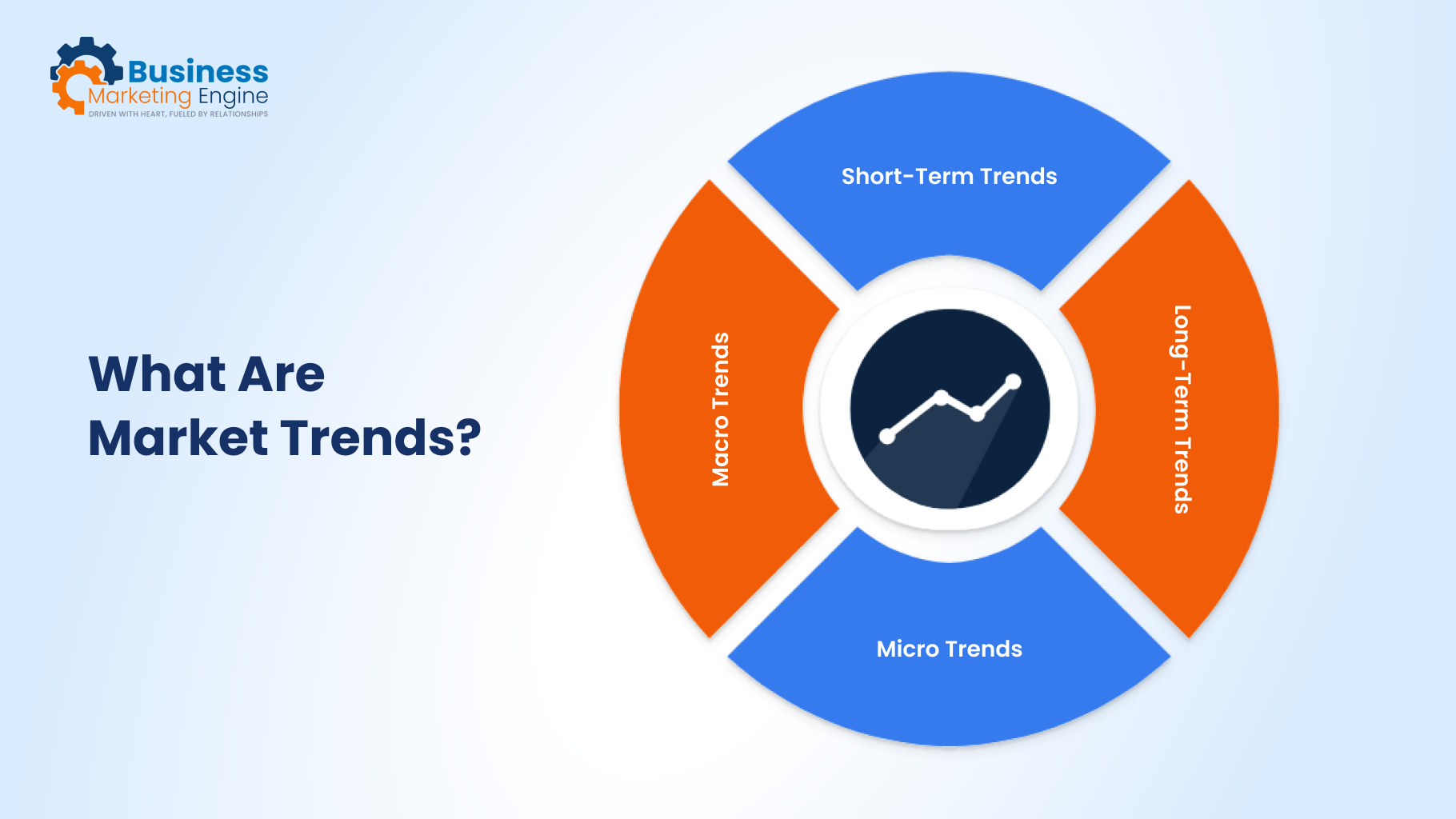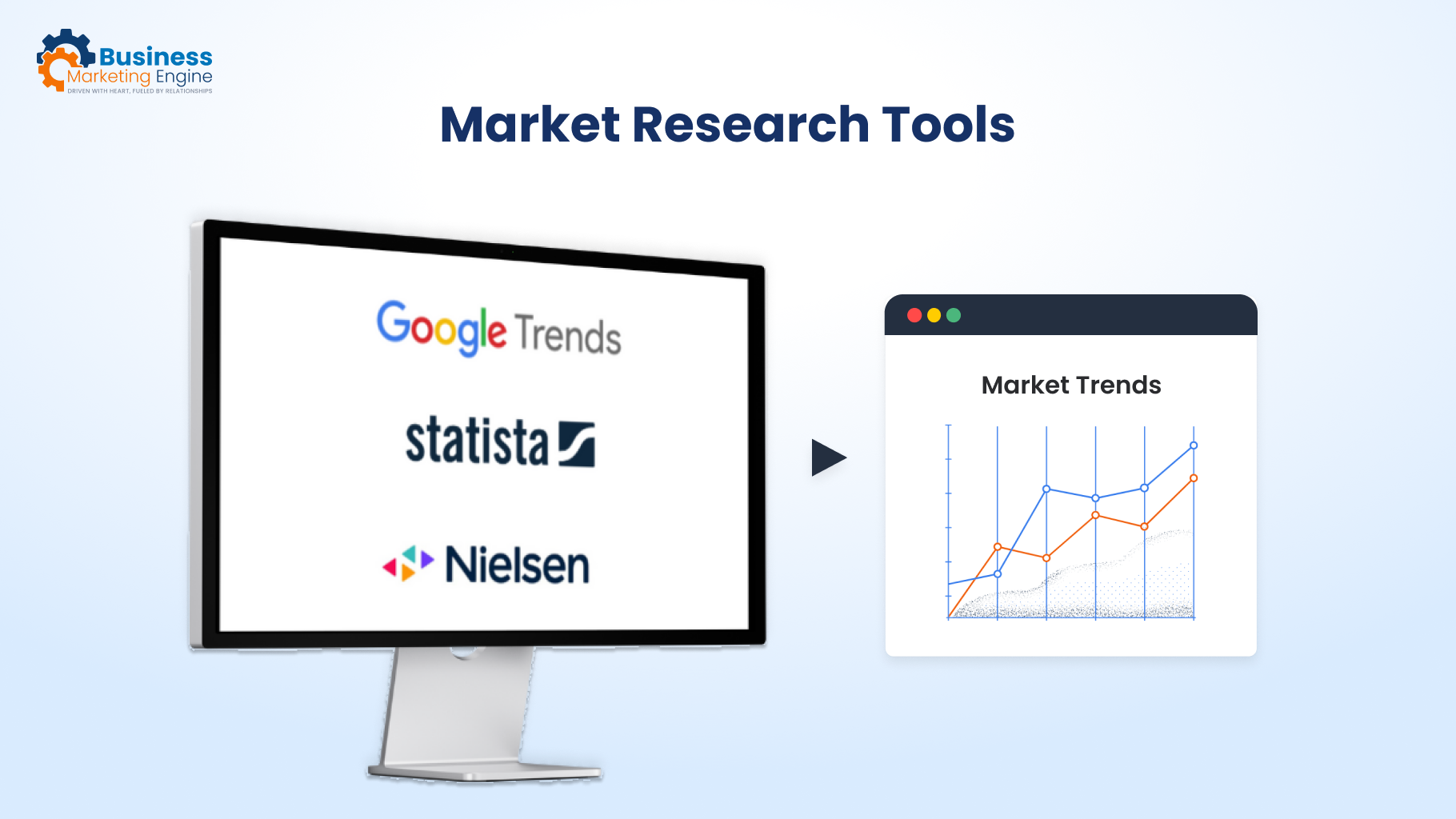Understanding market trends is critical if you want your business to succeed in the long run!
Market trends could be anything from changes in consumer behavior, tech advancements, or industry movements. And if you can tap into them early, you’ll know where to focus your energy and resources.
In this blog, we’re going to break down how you can easily analyze market trends to stay ahead of the curve. Ready to dive in?
Understanding Market Trends
To gain a better perspective, let’s first explore what market trends actually are.
What Are Market Trends?
Let’s start with the basics.
Market trends are patterns that you notice over time within your industry.
They help businesses understand how things are changing, whether that’s consumer preferences, tech developments, or economic shifts.
There are a few different types of market trends:
- Short-Term Trends: These are the fads that might pop up and last only for a few months (think viral TikTok products or limited-edition drops). They can be great for jumping on something new and capitalizing on immediate interest. But they don’t usually have long-term staying power.
- Long-Term Trends: These are the big shifts that happen over time. Long-term trends are important because they can change the way industries function for years to come. If you catch these early, you can build your business in a way that aligns with where things are headed.
- Micro Trends: Micro trends are the small, niche shifts that only a small group of people are into at first. They might seem insignificant at the start, but they can blow up. Pay attention to these if you want to stand out in a niche market.
- Macro Trends: These are the industry-wide shifts, like the rise of electric cars or renewable energy. Macro trends are the big ones that affect a ton of industries at once, and they tend to have lasting impacts.
So, by understanding these trends, you’ll know where the market is going and can adjust your business strategy accordingly.
Importance of Market Trend Analysis
Why does market trend analysis even matter?
When you pay attention to trends, you’re giving yourself the power to make smarter business decisions.
Without it, you’re just guessing, and that can lead to chaos (and yes, even failure!) for your business.
Here are some important factors to consider:
- Product Development: If you know what people want, you can create products or services that they’re going to love. Say you see that everyone’s starting to care about sustainability; now’s your chance to create an eco-friendly product before everyone else catches on.
- Marketing Strategies: Understanding the trends in your industry lets you plan ahead. Let’s say everyone’s going crazy for minimalism. If you’re running a fashion brand, maybe it’s time to start promoting a “less is more” campaign that aligns with that trend. It’s all about giving people what they’re looking for.
- Business Growth: If you’re staying on top of trends, you’ll be able to adapt quicker and find new ways to grow your business. It’s like knowing the best spot to fish because you’ve learned where all the fish are swimming. Stay ahead of trends, and your growth will follow.
Tools and Methods for Analyzing Market Trends
Now let’s go through the best tools to analyze dynamic market trends.
Market Research Tools
You don’t have to be some kind of data scientist to analyze market trends. There are tons of easy-to-use tools out there to help you:
- Google Trends: This is a total game changer. You can search for any keyword and see how much it’s being searched over time. This is great for figuring out if people are talking about your product or niche. You can also compare different keywords to see what’s trending the most.
- Statista: Statista is like a one-stop shop for market research. You can get access to industry reports, stats, and trends from just about every sector out there. It’s perfect for getting deep, reliable data to back up your decisions.
- Nielsen: This platform tracks consumer behaviors and trends, and it’s especially great for industries like retail and consumer goods. It helps you understand exactly how your target audience is feeling and what they want.
By using these tools, you’re not just guessing anymore.
You’ve got data and insights to help you make decisions like a pro.
Analyzing Competitor Behavior
Don’t sleep on what your competitors are doing.
Tracking what other businesses in your industry are up to can help you spot trends before they hit the market.
Here’s how to do it:
- Website Analysis: Take a look at what your competitors are doing on their websites. Are they launching new products? Changing their branding? If they’re pivoting in a new direction, it could be a sign of an emerging market trend that you should pay attention to.
- Social Media Monitoring: Social media is like the crystal ball for trends. If your competitors are getting tons of engagement on posts about a certain topic, that’s a big hint that it’s a trend you should explore too.
- Competitive Intelligence Tools: Platforms like SEMrush and SimilarWeb can help you track your competitors’ online activity. These tools let you see what keywords they’re ranking for and where their website traffic is coming from.
Customer Insights and Feedback
There’s no better way to understand market trends than hearing directly from your customers.
They’re the ones who are making the trends, so why not ask them what’s up?
- Surveys: Get a sense of your customers’ preferences by sending out surveys. Tools like SurveyMonkey or Google Forms make it easy to create and distribute surveys. You can ask questions about their preferences, needs, and what they’d like to see more of in your industry.
- Focus Groups: Focus groups are a great way to dive deeper into your customers’ thoughts. You can organize small groups of people to discuss a new idea or product. The feedback you get can help shape your next big move!
- Social Media Listening: Customers are always talking about what they like and dislike on social media. Use social listening tools like Brandwatch to monitor conversations and see if there are any emerging trends!
Social Media Listening
We all know social media is the place where trends explode.
When you monitor social media, make sure to look for:
- Trending Hashtags: Hashtags are like trend indicators. If you see certain hashtags popping up over and over, it’s a sign that something’s gaining traction. For example, if you see #sustainablefashion trending, that’s a trend you might want to pay attention to if you’re in the fashion industry.
- Sentiment Analysis: Tools like Talkwalker or Sprinklr can help you see how people are feeling about certain topics, products, or brands. Understanding whether consumers are excited or frustrated can tell you whether a market trend is worth investing in.
- Influencer Content: Influencers have a huge impact on shaping trends. By following the popular influencers in your niche, you can spot trends early.
Steps to Conduct a Market Trend Analysis
What are the steps to conduct a market trend analysis? Let’s dive in.
Step 1: Identify Relevant Market Trends
How do you figure out which market trends are actually worth paying attention to?
After all, you don’t want to waste time on every little thing that’s trending. Instead, focus on the ones that make the most sense for your business and where you want to go.
Here’s how to figure it out:
- Align with Your Business Goals: Market trends are great, but they have to fit into the bigger picture of what you want to achieve. For example, if your business is all about promoting self-care products, then trends around mental health are probably going to be more relevant to you.
- Stay Focused on Your Industry: Don’t go chasing trends just because they’re cool or hyped up. Make sure the trends you’re tracking are related to your industry. For instance, a sudden boom in digital banking might not impact a small boutique shop. But the rise of e-commerce and online shopping definitely will. Keep your research laser-focused on what matters.
- Pay Attention to Your Target Audience: What is your specific audience talking about? For instance, say you’re running a small candy brand, and you notice your target demographic is obsessed with sour candy. That’s your cue to start focusing on sour-based products. It’s all about making sure the trend aligns with your audience’s wants and needs.
- Filtering Out the Noise: Focus on the trends that align with your business. This will ensure you’re not spreading yourself too thin or wasting time on irrelevant hype. Use tools like Google Trends to narrow down which keywords or topics have staying power and aren’t just “flash-in-the-pan” trends.
You can even run small tests (e.g., polls on social media) to see if your audience is interested in the market trends you’re considering. This can save you a ton of time and effort!
Step 2: Collect and Analyze Data
Now that you know which trends you want to explore, it’s time to dive into the data.
How to Collect Good Data:
- Multiple Sources: Relying on just one source is like looking at a puzzle piece and trying to guess the whole picture. Use Google Trends for search volume, and industry reports for bigger picture data. Customer surveys are also great!
- Accuracy Is Key: It’s important to get data that is fresh and trustworthy. You don’t want to make decisions based on outdated numbers or unreliable sources.
- Don’t Forget Qualitative Data: While numbers and charts are great, it’s also important to collect qualitative data. What are customers saying on social media? How do they feel about certain products? You can use social media listening tools to get a read on the conversations around your industry.
- Analyzing the Data: Once you’ve got all this data, it’s time to analyze it and start looking for patterns. Are there trends emerging from customer feedback? Does the data show more searches for a certain product or service? The key is to look for consistent themes that point toward a broader trend.
And don’t forget to dig into the why behind the numbers. If you notice an increase in searches for a specific product, ask yourself, “Why are people interested in this now?” Maybe there’s a shift in consumer values, or maybe a cultural event sparked the interest.
Step 3: Forecast Future Trends
If you want to stay ahead of the curve, here are some techniques for forecasting:
- Use Historical Data: A lot of the time, looking at past trends can give you a pretty good idea of where things are heading. Let’s say you notice that the market trend of eco-friendly products has been growing steadily over the past 5 years. It’s probably safe to assume that this trend will continue, but maybe in a slightly different way.
- Predictive Analytics: Predictive tools can help you map out possible future outcomes based on your current data. If you’re seeing an increase in demand for dog food, then predictive analytics can help you estimate how big that trend will get in the next few years.
- Scenario Planning: You don’t have to predict everything with total accuracy. Instead, try mapping out different scenarios based on trends you see. Maybe one scenario is that the eco-friendly movement blows up, and another is that it remains a niche market.
Forecasting future trends allows you to set your business up for success in the long run. It gives you the tools to create proactive strategies rather than just reactive ones!
Step 4: Apply Insights to Business Strategy
So, you’ve gathered your data, forecasted future trends, and now it’s time to actually do something with it!
How to Apply Trend Insights:
- Product Development: Once you know which trends matter most to your business, you can start developing products around that. Let’s say you’ve analyzed data and noticed a trend toward plant-based foods. You could develop new plant-based snack options or even expand your menu to cater to this demand.
- Marketing Strategies: Knowing what’s trending allows you to build more relevant, timely campaigns. If you see that minimalism is a big trend in the design world, you could create a marketing campaign focused on clean, simple product designs that align with what’s popular.
- Business Model Tweaks: Maybe your business model needs to evolve based on trends. If subscription services are on the rise and you run a beauty brand, it might be time to offer a monthly beauty box.
- Resource Allocation: Trend analysis also helps you figure out where to put your money and time. Should you spend more on digital marketing because online shopping is booming? Or invest in developing a new product line? The insights from a market trend analysis will guide you.
When you apply these insights correctly, you can make strategic decisions that put you ahead of your competitors.
Just remember, the key is to stay flexible and ready to adjust as trends evolve!
Common Pitfalls to Avoid in Market Trend Analysis
Here are some common areas to avoid when analyzing market trends.
Overreliance on Historical Data
It’s easy to fall into the trap of thinking that past trends will always repeat themselves, but that’s not always the case.
Markets change, and you can’t just rely on old data to make predictions.
Keep checking in on newer sources of data to make sure you’re not missing anything that’s happening now. Combine the old with the new to get a more accurate picture.
Look for new data points, like social media chatter or the latest consumer surveys.
Don’t let past market trends lock you into a certain mindset; always be ready to pivot!
Ignoring Microtrends
Sometimes, it’s the tiny, niche trends that can make the biggest impact.
Microtrends might seem like nothing, but they’re often the precursor to something much bigger.
And overlooking them could mean missing out on huge opportunities.
Why You Should Care About Microtrends:
- They’re often the first indicators of something larger. If you catch these small shifts early, you’ll be one of the first to act and capitalize on them.
- Microtrends might not seem like much at first, but they could be the next big thing. Take the rise of plant-based food—what started as a small trend has become a huge market trend.
How to Spot Microtrends:
- Keep an eye on niche communities on platforms like Reddit or specialized forums. These often bubble up smaller trends before they get mainstream attention.
- Watch out for early-adopter influencers or bloggers. They often experiment with new products and ideas before the general public catches on.
Failing to Adapt to Rapid Changes
These days, trends change rapidly, and if your business is slow to adapt, you risk falling behind.
Here’s how to stay agile:
- Regularly monitor your market and competitors to spot new trends early.
- Be prepared to pivot quickly. This could mean adjusting your product line, marketing strategies, or even how you operate day-to-day.
- Encourage innovation and creative thinking within your business.
Conclusion
Understanding and analyzing market trends will set your business up for success.
Remember, trends aren’t static, they evolve – so be sure to stay flexible and proactive.
By gathering data, forecasting what’s coming next, and applying your findings strategically, you’ll be setting your business up for long-term growth.
So don’t wait for trends to pass you by! Get ahead of them and use market trend analysis to take your business to the next level.
Want more marketing and business expertise? Join our newsletter, The Markets Blueprint, to stay up-to-date on all the trends you need to know about!






